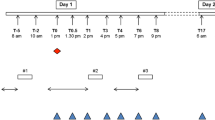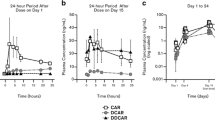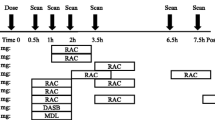Abstract
Rationale
Cariprazine is a novel antipsychotic drug candidate that exhibits high selectivity and affinity to dopamine D3 and D2 receptors and moderate affinity to serotonin 5-HT1A receptors. Targeting receptors other than D2 may provide a therapeutic benefit for both positive and negative symptoms associated with schizophrenia. Positron emission tomography (PET) can be used as a tool in drug development to assess the in vivo distribution and pharmacological properties of a drug.
Objectives
The objective of this study was to determine dopamine D2/D3 and serotonin 5-HT1A receptor occupancy in monkey brain after the administration of cariprazine.
Methods
We examined three monkeys using the following PET radioligands: [11C]MNPA (an agonist at D2 and D3 receptors), [11C]raclopride (an antagonist at D2 and D3 receptors), and [11C]WAY-100635 (an antagonist at 5-HT1A receptors). During each experimental day, the first PET measurement was a baseline study, the second after a low dose of cariprazine, and the third after the administration of a high dose.
Results
We found that cariprazine occupied D2/D3 receptors in a dose-dependent and saturable manner, with the lowest dose occupying ~5% of receptors and the highest dose showing more than 90% occupancy. 5-HT1A receptor occupancy was considerably lower compared with D2/D3 occupancy at the same doses, with a maximal value of ~30% for the raphe nuclei.
Conclusions
We conclude that cariprazine binds preferentially to dopamine D2/D3 rather than to serotonin 5-HT1A receptors in monkey brain. These findings can be used to guide the selection of cariprazine dosing in humans.




Similar content being viewed by others
References
Aalto S, Hirvonen J, Kajander J, Scheinin H, Nagren K, Vilkman H, Gustafsson L, Syvalahti E, Hietala J (2002) Ketamine does not decrease striatal dopamine D2 receptor binding in man. Psychopharmacology 164:401–406
Accili D, Fuchs S (1996) A new look at dopamine D3 receptors. Mol Psychiatry 1:93–4
Andree B, Nyberg S, Ito H, Ginovart N, Brunner F, Jaquet F, Halldin C, Farde L (1998) Positron emission tomographic analysis of dose-dependent MDL 100,907 binding to 5-HT2A receptors in the human brain. J Clin Psychopharmacol 18:317–323
Creese I, Burt DR, Snyder SH (1976) Dopamine receptor binding predicts clinical and pharmacological potencies of anti-schizophrenic drugs. Science 192:481–483
Farde L, Wiesel FA, Halldin C, Sedvall G (1988) Central D2 dopamine receptor occupancy in schizophrenic patients treated with antipsychotic drugs. Arch Gen Psychiatry 45:71–76
Farde L, Wiesel FA, Nordstrom AL, Sedvall G (1989) D1 and D2 dopamine receptor occupancy during treatment with conventional and atypical neuroleptics. Psychopharmacology 99(Suppl):S28–31
Farde L, Nordstrom AL, Wiesel FA, Pauli S, Halldin C, Sedvall G (1992) Positron emission tomographic analysis of central D1 and D2 dopamine receptor occupancy in patients treated with classical neuroleptics and clozapine. Relation to extrapyramidal side effects. Arch Gen Psychiatry 49:538–544
Farde L, Ginovart N, Ito H, Lundkvist C, Pike VW, McCarron JA, Halldin C (1997) PET-characterization of [carbonyl-11C]WAY-100635 binding to 5-HT1A receptors in the primate brain. Psychopharmacology 133:196–202
Farde L, Andree B, Ginovart N, Halldin C, Thorberg S (2000) PET-determination of robalzotan (NAD-299) induced 5-HT1A receptor occupancy in the monkey brain. Neuropsychopharmacology 22(4):422–429
Finnema SJ, Seneca N, Farde L, Shchukin E, Sovago J, Gulyas B, Wikstrom HV, Innis RB, Neumeyer JL, Halldin C (2005) A preliminary PET evaluation of the new dopamine D2 receptor agonist [11C]MNPA in cynomolgus monkey. Nucl Med Biol 32:353–360
Finnema SJ, Halldin C, Bang-Andersen B, Gulyás B, Bundgaard C, Wikström HV, Farde L (2009) Dopamine D2/D3 receptor occupancy of apomorphine in the nonhuman primate brain—a comparative PET study with [11C]raclopride and [11C]MNPA. Synapse 63:378–89
Graff-Guerrero A, Mamo D, Shammi CM, Mizrahi R, Marcon H, Barsoum P, Rusjan P, Houle S, Wilson AA, Kapur S (2009) The effect of antipsychotics on the high-affinity state of D2 and D3 receptors: a positron emission tomography study with [11C]-(+)-PHNO. Arch Gen Psychiatry Jun 66(6):606–15
Gurevich EV, Joyce JN (1999) Distribution of dopamine D3 receptor expressing neurons in the human forebrain: comparison with D2 receptor expressing neurons. Neuropsychopharmacology 20:60–80
Gurevich EV, Bordelon Y, Shapiro RM, Arnold SE, Gur RE, Joyce JN (1997) Mesolimbic dopamine D3 receptors and use of antipsychotics in patients with schizophrenia A postmortem study. Arch Gen Psychiatry 54:225–32
Gyertyán I, Kiss B, Sághy K, Laszy J, Szabó Gy K, Ágai-Csongor É, Gy D, Tihanyi K, Zs S (2006) RGH-188, an atypical antipsychotic with dopamine D3/D2 antagonist/partial agonist properties: behavioral characterization. Int J Neuropsychopharm 9(suppl 1):S222
Hall H, Sedvall G, Magnusson O, Kopp J, Halldin C, Farde L (1994) Distribution of D1 and D2 dopamine receptors, and dopamine and its metabolites in the human brain. Neuropsychopharmacology 11:245–256
Hall H, Halldin C, Dijkstra D, Wikstrom H, Wise LD, Pugsley TA, Sokoloff P, Pauli S, Farde L, Sedvall G (1996) Autoradiographic localisation of D3 dopamine receptors in the human brain using the selective D3 dopamine receptor agonist (+)-[3H]PD 128907. Psychopharmacology 128:240–247
Hall H, Lundkvist C, Halldin C, Farde L, Pike VW, McCarron JA, Fletcher A, Cliffe IA, Barf T, Wikstrom H, Sedvall G (1997) Autoradiographic localization of 5-HT1A receptors in the post-mortem human brain using [3H]WAY-100635 and [11C]WAY-100635. Brain Res 745:96–108
Halldin C, Gulyas B, Farde L (2001) PET studies with carbon-11 radioligands in neuropsychopharmacological drug development. Curr Pharm Des 7:1907–1929
Hargreaves RJ (2008) The role of molecular imaging in drug discovery and development. Clin Pharmacol Ther 83:349–53
Ichise M, Liow JS, Lu JQ, Takano A, Model K, Toyama H, Suhara T, Suzuki K, Innis RB, Carson RE (2003) Linearized reference tissue parametric imaging methods: application to [11C]DASB positron emission tomography studies of the serotonin transporter in human brain. J Cereb Blood Flow Metab 23:1096–1112
Ito H, Hietala J, Blomqvist G, Halldin C, Farde L (1998) Comparison of the transient equilibrium and continuous infusion method for quantitative PET analysis of [11C]raclopride binding. J Cereb Blood Flow Metab 18(9):941–50
Johansson L, Sohn D, Thorberg SO, Jackson DM, Kelder D, Larsson LG, Rényi L, Ross SB, Wallsten C, Eriksson H, Hu PS, Jerning E, Mohell N, Westlind-Danielsson A (1997) The pharmacological characterization of a novel selective 5-HT1A receptor antagonist, NAD-299. J Pharmacol Exp Ther 283:216–25
Karlsson P, Farde L, Halldin C, Swahn CG, Sedvall G, Foged C, Hansen KT, Skrumsager B (1993) PET examination of [11C]NNC 687 and [11C]NNC 756 as new radioligands for the D1 dopamine receptor. Psychopharmacology 113:149–156
Kegeles LS, Martinez D, Kochan LD, Hwang DR, Huang Y, Mawlawi O, Suckow RF, Van Heertum RL, Laruelle M (2002) NMDA antagonist effects on striatal dopamine release: positron emission tomography studies in humans. Synapse 43:19–29
Kiss B, Horváth A, Némethy Z, Schmidt E, Laszlovszky I, Bugovics G, Fazekas K, Hornok K, Orosz S, Gyertyán I, Agai-Csongor E, Domány G, Tihanyi K, Adham N, Szombathelyi Z (2010) Cariprazine (RGH-188), a dopamine D3 receptor-preferring, D3/D2 dopamine receptor antagonist–partial agonist antipsychotic candidate: in vitro and neurochemical profile. J Pharmacol Exp Ther 333:328–40
Lahti RA, Figur LM, Piercey MF, Ruppel PL, Evans DL (1992) Intrinsic activity determinations at the dopamine D2 guanine nucleotide-binding protein-coupled receptor: utilization of receptor state binding affinities. Mol Pharmacol 42:432–438
Langer O, Halldin C, Dolle F, Swahn CG, Olsson H, Karlsson P, Hall H, Sandell J, Lundkvist C, Vaufrey F, Loc'h C, Crouzel C, Maziere B, Farde L (1999) Carbon-11 epidepride: a suitable radioligand for PET investigation of striatal and extrastriatal dopamine D2 receptors. Nucl Med Biol 26:509–518
Le Foll B, Goldberg SR, Sokoloff P (2005) The dopamine D3 receptor and drug dependence: effects on reward or beyond? Neuropharmacology 49:525–541
Lee CM, Farde L (2006) Using positron emission tomography to facilitate CNS drug development. Trends Pharmacol Sci 27:310–316
Martin LL, Bouchal RL, Smith DJ (1982) Ketamine inhibits serotonin uptake in vivo. Neuropharmacology 21:113–118
Mathis CA, Simpson NR, Mahmood K, Kinahan PE, Mintun MA (1994) [11C]WAY 100635: a radioligand for imaging 5-HT1A receptors with positron emission tomography. Life Sci 55:PL403-7
Mikolajczyk K, Szabatin M, Rudnicki P, Grodzki M, Burger C (1998) A JAVA environment for medical image data analysis: initial application for brain PET quantitation. Med Inform 23:207–214
Millan MJ, Brocco M, Gobert A, Joly F, Bervoets K, Rivet J, Newman-Tancredi A, Audinot V, Maurel S (1999) Contrasting mechanisms of action and sensitivity to antipsychotics of phencyclidine versus amphetamine: importance of nucleus accumbens 5-HT2A sites for PCP-induced locomotion in the rat. Eur J Neurosci 11:4419–4432
Nyberg S, Nakashima Y, Nordström AL, Halldin C, Farde L (1996) Positron emission tomography of in vivo binding characteristics of atypical antipsychotic drugs. Review of D2 and 5-HT2 receptor occupancy studies and clinical response. Br J Psychiatry 168(Suppl. 29):40–44
Parsey RV, Arango V, Olvet DM, Oquendo MA, Van Heertum RL, John Mann J (2005) Regional heterogeneity of 5-HT1A receptors in human cerebellum as assessed by positron emission tomography. J Cereb Blood Flow Metab 25:785–793
Pike VW, McCarron JA, Lammerstma AA, Hume SP, Poole K, Grasby PM, Malizia A, Cliffe IA, Fletcher A, Bench CJ (1995) First delineation of 5-HT1A receptors in human brain with PET and [11C]WAY-100635. Eur J Pharmacol 283:R1–3
Rabiner E, Slifstein M, Nobrega J, Plisson C, Huiban M, Raymond R, Diwan M, Wilson AA, McCormick P, Gentile G, Gunn RN, Laruelle MA (2009) In vivo quantification of regional dopamine-D3 receptor binding potential of (+)-PHNO: studies in non-human primates and transgenic mice. Synapse Sep 63(9):782–93
Schotte A, Janssen PF, Gommeren W, Luyten WH, Van Gompel P, Lesage AS, De Loore K, Leysen JE (1996) Risperidone compared with new and reference antipsychotic drugs: in vitro and in vivo receptor binding. Psychopharmacology 124:57–73
Searle G, Beaver JD, Comley RA, Bani M, Tziortzi A, Slifstein M, Mugnaini M, Griffante C, Wilson AA, Merlo-Pich E, Houle S, Gunn R, Rabiner EA, Laruelle M (2010) Imaging dopamine D3 receptors in the human brain with positron emission tomography, [11C]PHNO, and a selective D3 receptor antagonist. Biol Psychiatry 68:392–9
Seeman P, Chau-Wong M, Tedesco J, Wong K (1975) Brain receptors for antipsychotic drugs and dopamine: direct binding assays. Proc Natl Acad Sci USA 72:4376–4380
Sibley DR, Creese I (1983) Regulation of ligand binding to pituitary D2 dopaminergic receptors: effects of divalent cations and functional group modification. J Biol Chem 258:4957–4965
Skinbjerg M, Namkung Y, Halldin C, Innis RB, Sibley DR (2009) Pharmacological characterization of 2-methoxy-N-propylnorapomorphine's interactions with D2 and D3 dopamine receptors. Synapse 63:462–75
Sokoloff P, Giros B, Martres MP, Bouthenet ML, Schwartz JC (1990) Molecular cloning and characterization of a novel dopamine receptor D3 as a target for neuroleptics. Nature 347:146–151
Sokoloff P, Diaz J, Le Foll B, Guillin O, Leriche L, Bezard E, Gross C (2006) The dopamine D3 receptor: a therapeutic target for the treatment of neuropsychiatric disorders. CNS Neurol Disord Drug Targets 5:25–43
Steiner H, Fuchs S, Accili D (1997) D3 dopamine receptor-deficient mouse: evidence for reduced anxiety. Physiol Behav 63:137–41
Suzuki M, Hurd YL, Sokoloff P, Schwartz JC, Sedvall G (1998) D3 dopamine receptor mRNA is widely expressed in the human brain. Brain Res 779:58–74
Tsukada H, Harada N, Nishiyama S, Ohba H, Sato K, Fukumoto D, Kakiuchi T (2000) Ketamine decreased striatal [11C]raclopride binding with no alterations in static dopamine concentrations in the striatal extracellular fluid in the monkey brain: multiparametric PET studies combined with microdialysis analysis. Synapse 37:95–103
Tziortzi AC, Searle GE, Tzimopoulou S, Salinas C, Beaver JD, Jenkinson M, Laruelle M, Rabiner EA, Gunn RN (2011) Imaging dopamine receptors in humans with [11C]-(+)-PHNO: dissection of D3 signal and anatomy. Neuroimage 54:264–277
Wienhard K, Dahlbom M, Eriksson L, Michel C, Bruckbauer T, Pietrzyk U, Heiss WD (1994) The ECAT EXACT HR: performance of a new high resolution positron scanner. J Comput Assist Tomogr 18:110–118
Wong DF, Tauscher J, Grunder G (2009) The role of imaging in proof of concept for CNS drug discovery and development. Neuropsychopharmacology 34:187–203
Acknowledgments
We thank the members of the Karolinska PET group for their assistance. This research was supported in part by the Intramural Program of the National Institute of Mental Health, Bethesda, Maryland, USA.
Author information
Authors and Affiliations
Corresponding author
Additional information
Christer Halldin and Balázs Gulyás have contributed equally to this work.
Rights and permissions
About this article
Cite this article
Seneca, N., Finnema, S.J., Laszlovszky, I. et al. Occupancy of dopamine D2 and D3 and serotonin 5-HT1A receptors by the novel antipsychotic drug candidate, cariprazine (RGH-188), in monkey brain measured using positron emission tomography. Psychopharmacology 218, 579–587 (2011). https://doi.org/10.1007/s00213-011-2343-z
Received:
Accepted:
Published:
Issue Date:
DOI: https://doi.org/10.1007/s00213-011-2343-z




